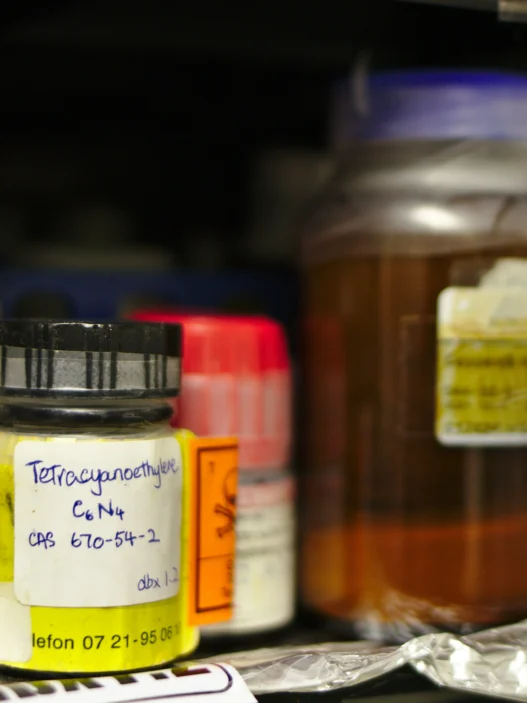1,2-(Methylenedioxy)-4-propenylbenzene, also known as safrole, is a compound present in certain essential oils, such as sassafras oil. While primarily used in the production of fragrances and flavorings, safrole has gained attention due to its potential health risks. Research has suggested safrole may have carcinogenic properties, prompting regulatory agencies to impose restrictions on its use in consumer products. As a result, the relevance of 1,2-(Methylenedioxy)-4-propenylbenzene to everyday life lies in its impact on human health and safety, particularly in the context of product formulation and regulation.
Table of Contents:
- 💡 Commercial Applications
- ⚗️ Chemical & Physical Properties
- 🏭 Production & Procurement
- ⚠️ Safety Considerations
- 🔬 Potential Research Directions
- 🧪 Related Compounds
💡 Commercial Applications
1,2-(Methylenedioxy)-4-propenylbenzene, commonly known as Safrole, has several commercial and industrial applications. It is frequently used as a fragrance and flavoring agent in the production of perfumes, soaps, and cosmetics. Additionally, Safrole is utilized in the manufacturing of pesticides and herbicides due to its insecticidal properties.
In the field of drug and medication applications, Safrole has been historically used in the synthesis of the recreational drug MDMA (Ecstasy). However, due to its potentially harmful effects on health, its use in this context is heavily regulated in many countries. Safrole has also been studied for its potential anti-inflammatory properties and its ability to inhibit certain enzymes, showing promise in the development of new medications for various health conditions.
Overall, 1,2-(Methylenedioxy)-4-propenylbenzene plays a significant role in various industries, particularly in fragrance and flavoring, as well as in the field of drug development and research. Its versatile properties make it a valuable compound for a range of applications, highlighting its importance in both commercial and medicinal sectors.
⚗️ Chemical & Physical Properties
1,2-(Methylenedioxy)-4-propenylbenzene, also known as safrole, appears as a colorless to pale yellow liquid with a sweet, spicy odor. It is commonly found in certain essential oils and used in the fragrance and flavor industries.
The molar mass of 1,2-(Methylenedioxy)-4-propenylbenzene is approximately 162.19 g/mol, with a density of around 1.096 g/cm³. This places it in the range of molar masses and densities of common food items such as sugar and salt.
1,2-(Methylenedioxy)-4-propenylbenzene has a melting point of around 11.86°C and a boiling point of approximately 232°C. These values are significantly higher compared to most common food items, whose melting points and boiling points are typically lower.
1,2-(Methylenedioxy)-4-propenylbenzene is insoluble in water, but soluble in organic solvents. It has a relatively low viscosity, making it flow easily. In comparison, common food items like sugar and salt are highly soluble in water and have varying viscosities depending on their concentration.
🏭 Production & Procurement
1,2-(Methylenedioxy)-4-propenylbenzene, also known as safrole, is predominantly produced through the extraction of sassafras oil. Sassafras oil is derived from the root bark of the sassafras tree, which is native to North America and East Asia. Safrole is a key component of sassafras oil, and it can be isolated through various chemical processes.
1,2-(Methylenedioxy)-4-propenylbenzene can be procured through the purchase of sassafras oil or safrole itself from chemical suppliers. Due to regulations on the use of safrole in certain industries, the procurement of this compound may be restricted in some regions. The transportation of 1,2-(Methylenedioxy)-4-propenylbenzene typically involves the use of secure containers to prevent leakage and ensure safe handling during transit.
In certain regions, the production and procurement of 1,2-(Methylenedioxy)-4-propenylbenzene may be subject to legal restrictions due to its use in the illicit production of illicit drugs such as MDMA. As a result, industries that utilize safrole in legitimate applications must adhere to strict regulations and guidelines to ensure compliance with the law. In order to prevent misuse and illegal activities, authorities may monitor the production and distribution of 1,2-(Methylenedioxy)-4-propenylbenzene.
⚠️ Safety Considerations
Safety considerations for 1,2-(Methylenedioxy)-4-propenylbenzene, also known as safrole, include potential skin and eye irritation upon contact. Inhalation of vapors may cause respiratory irritation and dizziness. It is important to handle this compound in a well-ventilated area and wear appropriate personal protective equipment, such as gloves and goggles, to minimize exposure.
Hazard statements for 1,2-(Methylenedioxy)-4-propenylbenzene include “Causes skin irritation” and “May cause respiratory irritation.” It is also noted as a suspected carcinogen and may cause genetic defects. These statements indicate the potential risks associated with handling this compound and emphasize the importance of using caution and following proper safety protocols.
Precautionary statements for 1,2-(Methylenedioxy)-4-propenylbenzene include “Avoid breathing vapors” and “Wear protective gloves/eye protection.” It is also recommended to keep the compound away from heat, sparks, and open flames to prevent fire hazards. In case of accidental exposure or ingestion, it is advised to seek medical attention immediately and provide the medical personnel with relevant information about the substance.
🔬 Potential Research Directions
1,2-(Methylenedioxy)-4-propenylbenzene, also known as isosafrole, has been a focus of research due to its wide range of biological activities, including antifungal and insecticidal properties. Future research directions could explore the potential applications of this compound in pharmaceuticals and agrochemicals.
Studies on the mechanisms of action of 1,2-(Methylenedioxy)-4-propenylbenzene could shed light on its mode of action and potential targets in various organisms. Further investigation into its interactions with enzymes and receptors could lead to the development of new therapeutic agents and pesticides.
Investigations into the synthesis and purification methods of 1,2-(Methylenedioxy)-4-propenylbenzene could enhance its production efficiency and yield, making it more accessible for research and commercial purposes. The development of novel synthetic routes and optimization of existing procedures could contribute to the advancement of this compound’s utilization in various industries.
🧪 Related Compounds
One similar compound to 1,2-(Methylenedioxy)-4-propenylbenzene is safrole. Safrole has a molecular structure similar to 1,2-(Methylenedioxy)-4-propenylbenzene, with a benzene ring and a propenyl group. However, safrole does not contain the methylenedioxy group found in 1,2-(Methylenedioxy)-4-propenylbenzene.
Another compound resembling 1,2-(Methylenedioxy)-4-propenylbenzene is myristicin. Myristicin shares a similar molecular structure with 1,2-(Methylenedioxy)-4-propenylbenzene, containing a benzene ring and a propenyl group. However, myristicin lacks the methylenedioxy group present in 1,2-(Methylenedioxy)-4-propenylbenzene.
Additionally, elemicin is another compound with a structure akin to 1,2-(Methylenedioxy)-4-propenylbenzene. Elemicin consists of a benzene ring and a propenyl group, similar to the molecular structure of 1,2-(Methylenedioxy)-4-propenylbenzene. However, elemicin does not contain the unique methylenedioxy group found in 1,2-(Methylenedioxy)-4-propenylbenzene.




